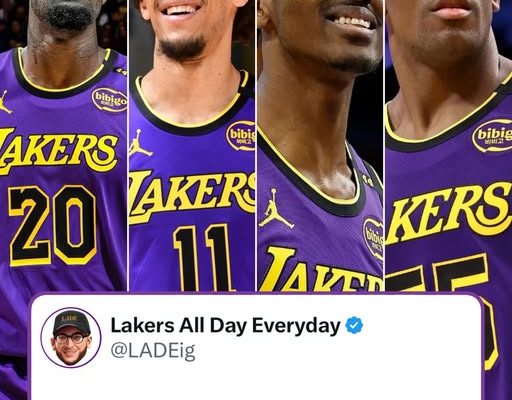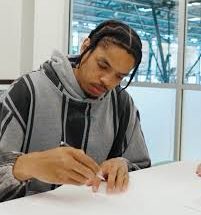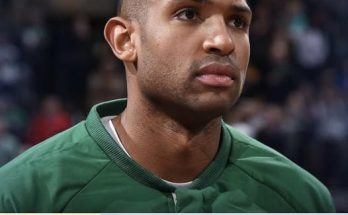The Los Angeles Lakers have long been a team defined by their star power and championship pedigree, but in recent years, their roster construction has drawn criticism for its lack of balance—particularly in the size and rim-protection department. As the NBA continues to evolve with positionless basketball and stretch bigs becoming more prevalent, the Lakers have found themselves undersized at times, relying heavily on Anthony Davis to shoulder an overwhelming defensive burden. That trend might finally be changing. In a move that’s being praised across NBA circles, the Lakers have added some much-needed height to their roster, and it’s already transforming how insiders, analysts, and even fans view their upcoming season.
To understand the significance of this move, it’s important to appreciate the broader context of the Lakers’ struggles in recent seasons. Despite having one of the most talented cores in the league—featuring LeBron James and Anthony Davis—the team has been inconsistent. Injuries, poor perimeter shooting, and a lack of size in the frontcourt have all played major roles in their inability to make deeper playoff runs since winning the 2020 NBA Championship in the bubble. While LeBron’s ageless dominance and Davis’ elite two-way play have kept the Lakers relevant, the lack of reliable interior presence beyond Davis has forced the coaching staff to stretch the minutes and physical demands placed on him. Even during the playoffs, the absence of a legitimate backup big or a mobile 7-footer to support Davis in guarding elite centers like Nikola Jokić or Joel Embiid was glaring.
That’s where the Lakers’ recent roster addition becomes particularly intriguing. This offseason, the team has prioritized shoring up the paint with the acquisition of several long, athletic big men who bring not just size, but mobility, rebounding, and shot-blocking. Among the most talked-about is undrafted standout Colin Castleton, who showed tremendous upside during the Summer League. Though he’s not the headliner, Castleton brings a unique blend of size (standing at 6’11”), vision, and footwork. He played four years in college and developed into a smart interior defender with solid fundamentals. The Lakers giving him a two-way contract shows their recognition of potential and the need to cultivate rim protection that can help Davis and reduce the heavy burden on his body.
But Castleton is just the beginning. The team has also moved to bring in veteran bigs who can log playoff minutes and offer toughness in the trenches. This includes players like Jaxson Hayes, who may not have lived up to his lottery-pick billing with the New Orleans Pelicans but is still a physical specimen with a 7-foot frame, pogo-stick hops, and the ability to switch in pick-and-rolls when locked in. The Lakers see in Hayes a project, yes, but also a player who—if developed properly—could become the high-energy vertical spacer and shot-challenger they’ve desperately lacked in the rotation.
Another name that’s drawn attention is Christian Wood, who, despite his reputation as a journeyman and defensive liability, adds undeniable size and offensive talent to the frontcourt. At 6’10” with a 7’3″ wingspan, Wood can space the floor from the five position and create mismatches in pick-and-pop scenarios. While his defensive consistency has long been questioned, his physical tools make him an intriguing player if the Lakers can cultivate better habits. Darvin Ham and his coaching staff are betting that the team’s culture and leadership will bring out more focus and effort in Wood, especially since he’s on a prove-it deal.
This commitment to adding size isn’t just about roster depth—it’s also a tactical evolution. In past years, the Lakers leaned heavily on smaller lineups with LeBron or Rui Hachimura playing the four, flanked by wings and guards who could shoot and switch defensively. While those lineups can work in spurts, they often leave the rim unprotected and place too much responsibility on Davis. With more height on the bench, the coaching staff now has the flexibility to mix and match lineups depending on the matchup. Want to go big against Denver or Milwaukee? Pair Davis with Hayes or Castleton. Want to maintain spacing while staying tall? Slot in Wood next to Davis. Need a high-energy lineup to crash the boards? Use all three and let the wings funnel drivers into a wall of arms.
From a developmental standpoint, having more size also helps in practice and scrimmages. One underrated issue over the last couple of seasons has been the lack of physical bigs in practice to simulate game conditions. Having young, hungry players like Castleton or Dominick Barlow—if acquired—or two-way project centers gives the coaching staff more to work with. Iron sharpens iron, and when Davis or Hachimura have to go against seven-footers in drills, it prepares them for the physicality of the regular season and postseason.
It’s also worth noting how this move aligns with broader league trends. Across the NBA, teams are realizing that size still matters—especially in the playoffs. The success of the Denver Nuggets, for instance, has showcased how important it is to have a dominant, mobile, playmaking center. Jokić not only scores but initiates offense, rebounds, and makes timely stops when needed. Against teams that lack size, he simply overwhelms. The Lakers experienced this firsthand during the 2023 Western Conference Finals, where Davis was often isolated and lacked help defending Jokić. The hope is that with more big bodies available, the Lakers can throw different looks at elite centers, preserve Davis’ energy, and play more physical in the paint.
Of course, adding size alone doesn’t guarantee success. Chemistry, health, and execution will always play a bigger role. However, by bringing in more height, the Lakers are addressing one of their most persistent weaknesses. More importantly, it allows the rest of the team to slot into more natural roles. LeBron, for instance, won’t have to bang down low as often, which could be crucial as he enters his 22nd NBA season. Having a frontcourt that can absorb physical play opens the door for him to operate as more of a facilitator and late-game closer, rather than doing the dirty work for 30 minutes a night.
The addition of height also impacts the team’s perimeter defense. When you have elite rim protection behind you, guards can be more aggressive in fighting through screens, knowing there’s help behind them. This trickle-down effect can make players like D’Angelo Russell, Gabe Vincent, and Austin Reaves more effective at the point of attack. And for a team that’s often struggled with perimeter containment, that’s an underrated benefit.
From a fan perspective, these moves reflect a front office that is finally listening to feedback and adjusting accordingly. Rob Pelinka and his staff have been under heavy scrutiny for lopsided roster builds in recent years, especially during the failed Russell Westbrook era. By investing in size, they’re not just patching holes—they’re building a team that can adapt. The NBA is fluid, and playoff matchups often expose whatever weakness a team has. With height now on the roster, the Lakers are better equipped to handle whatever comes their way.
There’s also a long-term component to this strategy. While LeBron and Davis are still the anchors, both are aging stars. Developing young bigs like Castleton could be key to sustaining success beyond their primes. Much like how teams like the Spurs or Heat develop in-house talent, the Lakers seem to be taking a page from that playbook. Instead of constantly chasing stars in free agency, there’s value in identifying niche players who can grow within your system. And height, unlike shooting or ball-handling, can’t be taught. Finding bigs with the right attitude and teaching them how to be effective role players could become the Lakers’ secret weapon in years to come.
Let’s not forget the psychological impact of having size. Teams play differently when they know there’s a shot-blocker lurking in the paint. It changes driving angles, affects midrange timing, and often leads to rushed or altered shots. During the Lakers’ 2020 title run, having Dwight Howard and JaVale McGee as physical enforcers was a key part of their identity. That intimidation factor hasn’t been present in recent years. With the new acquisitions, the Lakers are reclaiming some of that edge.
This shift toward size also allows Davis to play more power forward—a position he prefers. While he’s embraced the center role out of necessity, he’s repeatedly expressed a desire to play alongside another big, especially during the regular season. By keeping him at the four, the Lakers can reduce wear and tear, preserve his mobility, and allow him to operate more freely on both ends of the floor. It’s a win for Davis and for the team’s overall structure.
And finally, the financial side must be addressed. The Lakers didn’t break the bank to add this height. Instead, they made calculated low-cost moves, betting on development and upside rather than splashy contracts. It’s a smart pivot from their past strategy, which often relied on big-name signings that didn’t always fit the team’s needs. These signings don’t inhibit flexibility for future trades or free-agent pursuits, keeping the Lakers nimble as the trade deadline or buyout market approaches.
In the end, the decision to prioritize height reflects a more mature, thoughtful approach to roster building. It’s about depth, versatility, and playing the long game. While the Lakers still have questions to answer—like who their starting five will be, whether LeBron can continue defying age, or if they can stay healthy through a brutal Western Conference—their newfound size gives them a better chance of answering those questions positively.
The Lakers didn’t just add bodies; they added possibilities. They expanded their lineup options, improved their rim protection, fortified their bench, and took steps toward reducing the physical load on their stars. In a league where matchups are everything and every inch matters, adding height isn’t just a cosmetic change—it’s a strategic evolution. One that might just tip the scales back in purple and gold’s favor.



